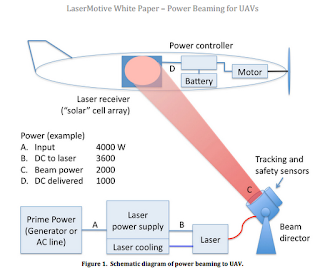 |
| Lockheed Martin Stalker |
 |
| A visual summary of how the system works. Credits to techcentre.in |
In the test, the Stalker was modified for compatibility with LaserMotive's laser recharging system through the installation of special photo voltaic cells on the drone (as you can deduce, the way this system works is very similar to that of solar panels). The Stalker was then placed to fly in a wind tunnel under flight conditions so the laser does not have to constantly track and adjust for the drone's position that would have been necessary if it was actually in fight. Results were overwhelmingly positive as the drone seemed to be able to stay in flight indefinitely with the battery power being higher than when the test started. The test team only stopped at 48 hours because it was already greatly passed their originally set endurance goals. Without the laser power system, the Stalker's battery can only last a maximum of 2 hours.
Although this tremendous rate of power transfer by LaserMotive's wireless recharging systems will be a huge step forward for electric aircraft flight endurance and wireless recharging technology overall, it definitely isn't good news for birds everywhere.


1 comment:
You might qualify for a new solar rebate program.
Click here to discover if you're eligble now!
Post a Comment